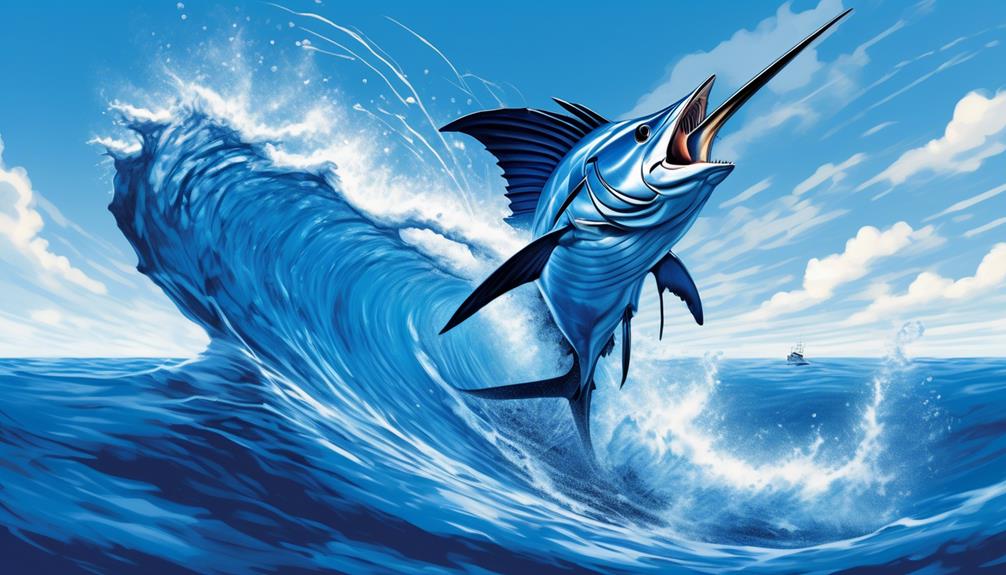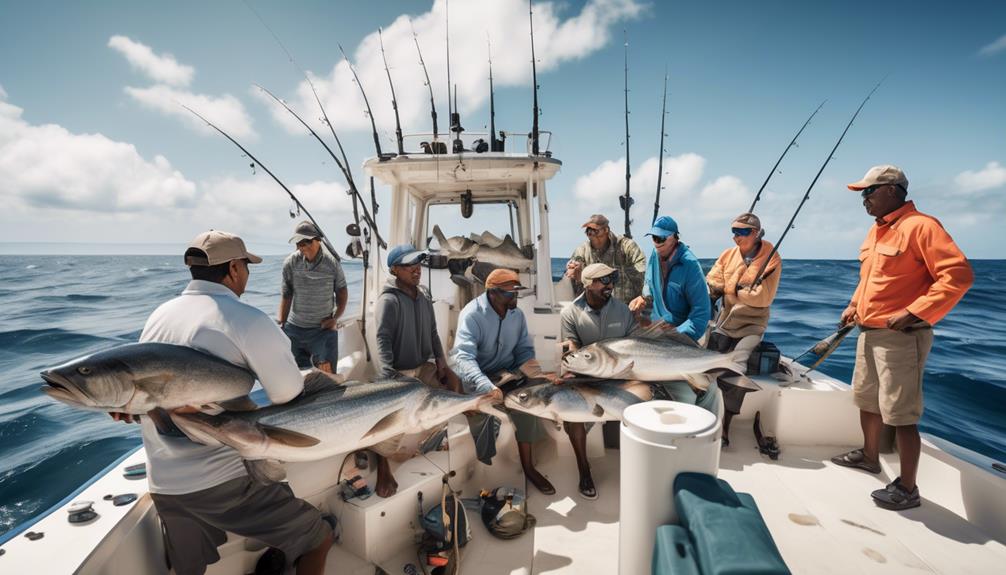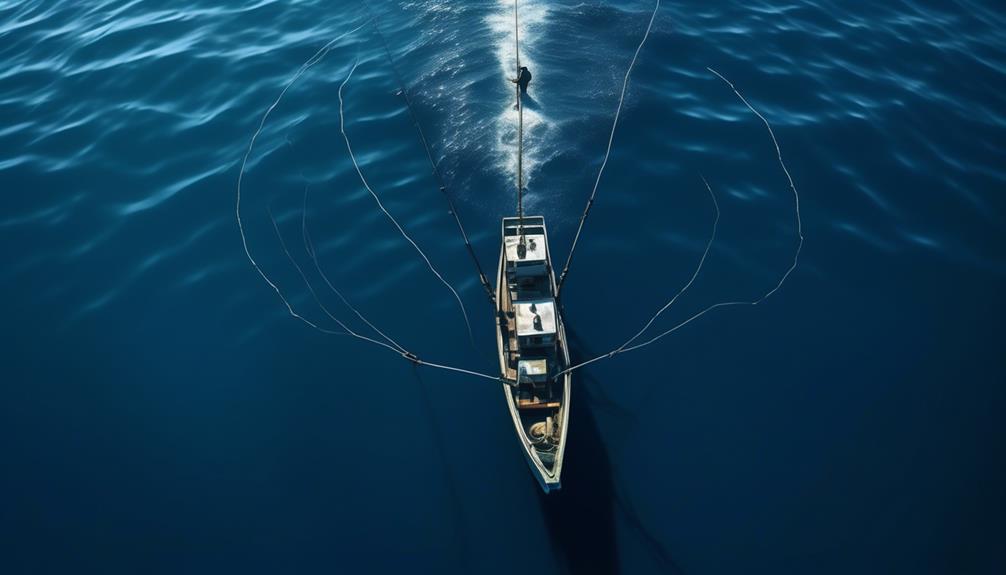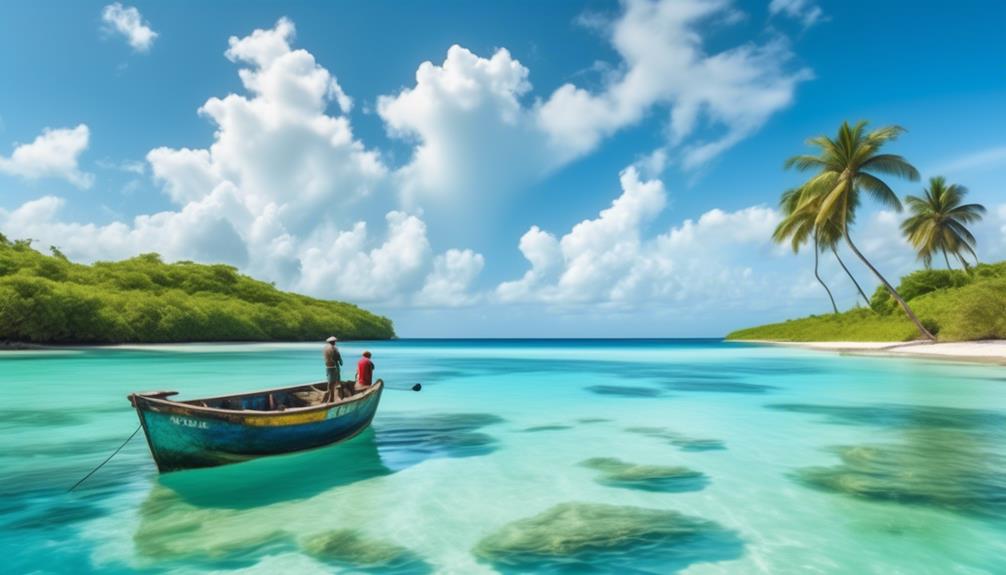So, you think catching trophy-sized marlin is as easy as reeling in a goldfish, huh? Well, think again. Landing one of these majestic creatures requires skill, patience, and a deep understanding of their behavior.
But fear not, with the right techniques and strategies, you can increase your chances of hooking that prized marlin. From selecting the perfect bait to mastering the art of trolling, there are several key tips that can elevate your game.
Stick around to uncover the secrets that will give you an edge in the pursuit of trophy-sized marlin.
Understanding Marlin Behavior
Observing marlin behavior is essential for increasing your chances of catching trophy-sized fish. Understanding their movements and feeding habits will greatly improve your success as an angler.
Marlin are apex predators with powerful predatory instincts. They're known for their aggressive nature, often striking with incredible speed and force. By observing their behavior, you can gain valuable insights into their predatory instincts, allowing you to anticipate their actions and adjust your fishing techniques accordingly.
Feeding patterns play a crucial role in understanding marlin behavior. These majestic creatures are opportunistic feeders, often targeting schools of fish near the surface. They're known to follow warm ocean currents, where baitfish are abundant. By understanding their feeding patterns, you can strategically position your bait or lures to mimic the movement of their prey, increasing the likelihood of enticing a marlin to strike. Additionally, observing their feeding behavior can help you identify the most productive times of day for marlin fishing.
To effectively catch trophy-sized marlin, it's essential to comprehend their behavior in their natural habitat. By recognizing their predatory instincts and understanding their feeding patterns, you can become a more skilled angler. This knowledge won't only enhance your chances of hooking a marlin but also contribute to the conservation of these remarkable species by promoting responsible and sustainable fishing practices.
Selecting the Right Bait and Lures
To increase your chances of catching trophy-sized marlin, selecting the right bait and lures is crucial for enticing these apex predators. When it comes to bait presentation, it's essential to mimic natural prey behavior to attract marlin. Here's how you can optimize your bait and lure selection:
- Natural Movement: Marlin are attracted to bait that moves naturally in the water. Consider using live bait such as bonito, mullet, or mackerel to simulate the erratic movements of injured prey. Using a kite fishing technique can also create lifelike movements that entice marlin to strike.
- Lure Size: Choose lures that match the size of the natural prey in the area. Large marlin are more likely to be enticed by larger lures, while smaller lures may attract smaller marlin. Matching the size of the lure to the prevailing baitfish can significantly improve your chances of a successful catch.
- Lure Colors: The color of your lures can play a crucial role in attracting marlin. Brightly colored lures such as pink, blue, and silver often work well in offshore waters. These colors stand out in deep water and can grab the attention of marlin from a distance.
- Depth Control: Pay attention to the diving depth of your lures. Marlin may be found at different depths depending on the time of day and water temperature. Using lures with adjustable diving depths can help you target marlin at various levels in the water column.
- Bait Rigging: Properly rigging your bait can make a significant difference. Ensure that your bait is rigged to swim naturally, and consider using circle hooks to improve hook-up ratios while minimizing harm to the fish.
Mastering the Art of Trolling
Want to increase your chances of catching trophy-sized marlin? Mastering the art of trolling is essential for targeting these elusive predators.
When it comes to trolling for marlin, employing advanced tactics and mastering the nuances of trolling techniques can make all the difference. One key aspect of trolling is the speed at which you move through the water. Marlin are known for their speed and agility, so it's crucial to maintain an optimal trolling speed that mimics the movement of natural prey. This often involves varying your speed throughout the trolling process to attract and entice marlin into striking.
Additionally, lure selection plays a critical role in the art of trolling for marlin. Understanding the different types of lures, their movements, and how they interact with the water is vital. Experienced anglers often utilize a combination of lures, including surface lures, diving plugs, and skirted lures, to present a variety of options to the marlin and increase the likelihood of a successful strike. Furthermore, mastering the art of deploying and maneuvering these lures can significantly enhance your trolling game.
To truly master the art of trolling for marlin, it's essential to continually refine your techniques, adapt to changing conditions, and remain attentive to the behavior of these majestic creatures. By honing your trolling skills, understanding the intricacies of trolling speed, and perfecting your lure selection, you can greatly increase your chances of landing that coveted trophy-sized marlin.
Perfecting Your Hook Setting Technique
When perfecting your hook setting technique after mastering the art of trolling for marlin, focus on maintaining a firm yet controlled grip on the rod, ensuring a swift and decisive motion to set the hook securely. This is crucial for successfully landing trophy-sized marlin.
To perfect your hook setting technique, consider the following tips:
- Hook Accuracy: Aim to direct the hook towards the corner of the marlin's mouth, where it's most likely to penetrate and hold securely. This requires precise aim and control over the rod to ensure the hook lands in the ideal location.
- Timing Strategy: Wait for the right moment to set the hook. As the marlin takes the bait and starts to swim away, it's essential to gauge the timing for the hook set. Setting the hook too early or too late can result in a missed opportunity to secure the catch.
- Maintain Tension: Keep the line taut throughout the hook setting process. This tension is essential for ensuring the hook penetrates the marlin's tough mouth and stays embedded securely.
- Swift Motion: Execute the hook set with a swift and deliberate motion. A quick, forceful movement of the rod helps drive the hook home and increases the chances of a successful hook set.
- Practice Patience: It takes time and practice to perfect the timing and technique of hook setting. Be patient and persistent in honing this skill, as it can significantly impact your success in catching trophy-sized marlin.
Maneuvering the Boat for Success
Position your boat strategically to optimize your chances of hooking a trophy-sized marlin when maneuvering for success. Boat positioning is crucial when it comes to navigating the waters for a successful catch.
When tracking marlin, it's important to position your boat in a way that allows for the best visibility of the fish. This might involve circling around the marlin, positioning the boat to cut off its potential escape routes, or even backing down to stay on the fish. The goal is to keep the marlin within sight and maintain the best possible angle for hooking it.
Additionally, understanding ocean currents and wind patterns is essential for maneuvering the boat effectively. Knowledge of these factors can help you anticipate the movement of the marlin and position your boat accordingly.
For instance, using the natural drift caused by ocean currents can aid in presenting the bait in a way that entices the marlin. Similarly, being mindful of wind patterns can assist in positioning the boat for an optimal fishing experience.
Handling and Releasing the Catch Ethically
To ensure the ethical handling and release of your catch, carefully remove the hook while minimizing stress to the fish. It's important to consider ethical considerations and conservation efforts when handling and releasing trophy-sized marlin. Here are some key points to keep in mind:
- Minimize Handling Time: Limit the time the fish is out of the water as much as possible. Prolonged handling can cause stress and exhaustion, reducing the chances of survival upon release.
- Use Proper Handling Techniques: Support the fish horizontally to avoid damage to internal organs. Avoid lifting the fish by its gills or tail, as this can cause serious harm.
- Remove Hooks Safely: Use appropriate tools to safely remove the hook. If the hook is deeply embedded, consider cutting the line close to the hook instead of trying to remove it, as this can reduce harm to the fish.
- Revive the Fish: If the fish appears exhausted after the fight, revive it by gently moving it back and forth in the water to ensure proper oxygen flow through its gills before releasing it.
- Follow Size and Limit Regulations: Familiarize yourself with size and limit regulations in the area you're fishing. Respecting these regulations contributes to conservation efforts and ensures sustainable fish populations for the future.
Navigating Weather and Water Conditions
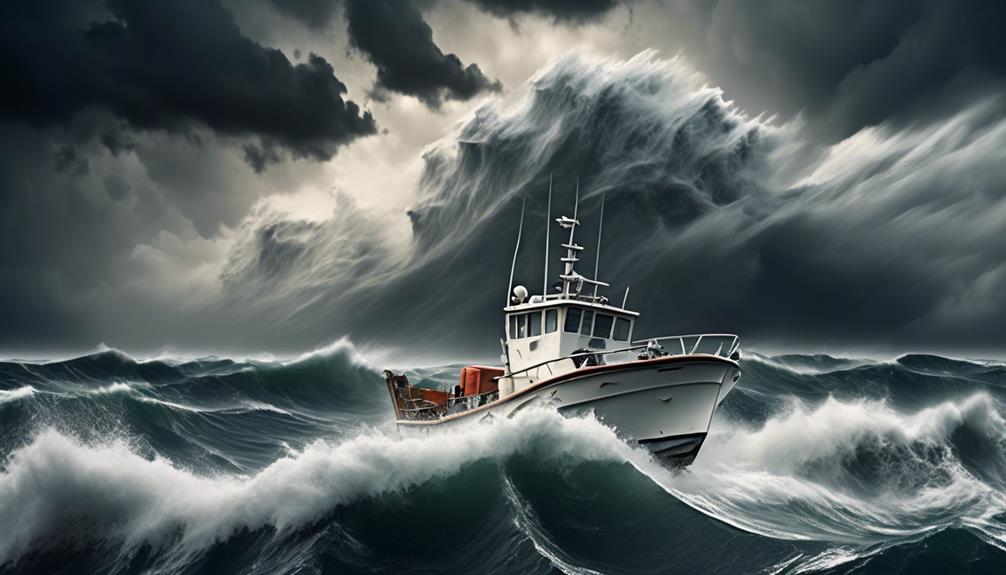
As you prepare for your marlin fishing expedition, stay informed about current weather and water conditions to ensure a safe and successful outing. Understanding currents and wind patterns is crucial for a successful marlin fishing trip.
When navigating the open waters, it's essential to be aware of the direction and strength of currents. Knowledge of these currents can help you position your boat strategically to increase your chances of finding marlin hotspots.
Additionally, understanding wind patterns is important for boat handling and locating the optimal fishing grounds. Pay attention to wind direction and speed as they can impact the movement of baitfish and the behavior of marlin.
Safety precautions are paramount when dealing with unpredictable weather and water conditions. Before heading out, always check the weather forecast and heed any warnings or advisories. Be prepared to adjust your plans if unfavorable conditions arise.
It's also crucial to ensure that your boat is equipped with necessary safety equipment and that all passengers are briefed on emergency procedures. When facing challenging conditions, such as rough seas or strong winds, practicing proper boat handling techniques is essential. Maintain a firm grip on the helm, adjust your speed, and use caution when navigating through rough waters.
Staying Safe and Prepared at Sea
When navigating the open waters, your safety and preparedness at sea are vital considerations for a successful marlin fishing trip. To ensure a safe and enjoyable experience, it's crucial to prioritize sea safety and emergency preparedness.
- Check Weather Conditions: Before setting out, always check the weather forecast and sea conditions. Sudden changes in weather can pose significant risks, so staying informed is essential.
- Safety Equipment: Ensure that your boat is equipped with essential safety gear such as life jackets, first aid kit, emergency flares, and a functioning radio for communication. These items can be lifesaving in case of an emergency.
- Navigation Tools: Familiarize yourself with navigation tools such as GPS, charts, and compass. Knowing how to use these tools can help you find your way back to shore if you encounter unexpected challenges.
- Emergency Plan: Develop a clear emergency plan and communicate it to everyone on board. Establish emergency roles and procedures for different scenarios, including man overboard, engine failure, or medical emergencies.
- Training and Certification: Consider taking a boating safety course and obtaining relevant certifications. Proper training can enhance your knowledge of sea safety practices and equip you with the skills to handle unforeseen circumstances.
Frequently Asked Questions
What Are the Best Locations Around the World for Catching Trophy-Sized Marlin?
For top fishing charters and the best fishing seasons to catch trophy-sized marlin, check out locations like Hawaii, Australia, and Costa Rica. These spots offer prime opportunities to reel in some impressive catches.
What Are Some Lesser-Known Techniques for Attracting Marlin to the Boat?
To attract marlin to the boat, try using lures, chumming, and live bait. Deep sea fishing and trolling techniques are also effective. Experiment with different strategies to see what works best for you.
How Can You Properly Estimate the Size of a Marlin Before Attempting to Reel It In?
Before attempting to reel in a marlin, you can estimate its size by observing its behavior and comparing it to the boat or using proven estimation techniques. Look for visual cues and use your experience to gauge its size accurately.
What Are Some Common Mistakes Anglers Make When Trying to Catch Trophy-Sized Marlin?
When trying to catch trophy-sized marlin, common mistakes include poor preparation and ineffective baiting. Overcoming challenges requires proper planning and patience. Ensure you're equipped with the right gear and techniques to increase your chances of success.
What Are the Best Ways to Preserve and Display a Trophy-Sized Marlin Catch?
To preserve and display a trophy-sized marlin catch, consider using preserving techniques or the taxidermy process. Both methods can help you create a lasting memento of your impressive catch that you can proudly display.
Conclusion
So, now that you have learned the best tips for catching trophy-sized marlin, it's time to put your knowledge to the test.
Remember to stay patient, observe marlin behavior, and use the right bait and lures.
Master the art of trolling, perfect your hook setting technique, and maneuver the boat for success.
Always handle and release your catch ethically, and stay safe and prepared at sea.
Good luck and happy fishing!
